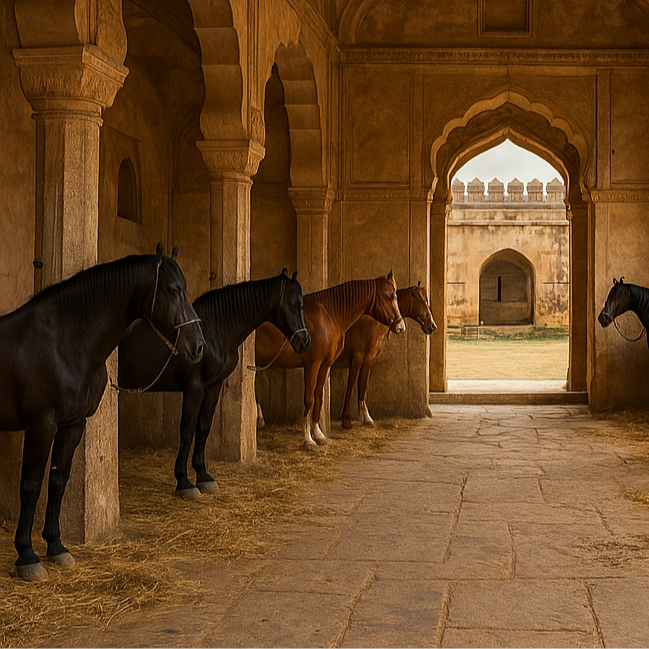
The Royal Stables of India
Share
Beyond rose gardens and courtyards filled with shehnai, and tucked away behind the sandstone arches of palaces, was another realm of royalty, one created not for kings but for the animals that carried them. The royal stables of India were not mere enclosures; they were sanctums of pride, symbols of status, and monuments to the unspoken brotherhood between horse and rider.
To walk through the royal stables of Udaipur, Bikaner, or Mysore is to step into a chapter of Indian history often whispered but never shouted—where architecture met affection and horses lived in quarters worthy of kings.
Architectural Grace for Galloping Grace
From the marble-pillared stables of Rajasthan to the intricately latticed enclosures in Hyderabad, the design of royal stables reflected the grandeur of the palaces they served. These were not makeshift barns — they were thoughtfully planned halls with high, ventilated ceilings, carved arches, and polished stone floors that stayed cool in the heat. The spaces were often aligned with courtyards, fountains, and water troughs sourced from nearby stepwells — a marriage of form and function, designed to keep the animals comfortable and calm.
In some estates, horses even had their own jharokhas — little balconies from which royal grooms could observe their behavior and health. The Gwalior stables, for example, were said to resemble the palace zenana in layout and detail, as the rulers considered the horses family.
Rituals of Reverence
In India’s royal courts, horses were not just modes of transport or war. They were sacred. Some kings even consulted astrologers before assigning a horse to a prince. Grooming them was a ceremonial affair: manes were oiled with perfumed essences, hooves were polished with natural wax, and saddles were embroidered with royal insignia in gold and silver thread.
Festivals like Ashwa Poojan celebrated the spiritual importance of horses — with tilaks applied to their foreheads, garlands around their necks, and prayers offered to honor their role in dharma and warfare alike.
Breeds of the Bloodline
The stables were home to the finest breeds — Marwari horses, known for their inward-curving ears and desert endurance; Kathiawaris, built for speed and stamina; Zaniskaris of Ladakh, sure-footed in snow-covered terrain; and Manipuri ponies, once used in royal games of polo.
Imported Arabian and Persian horses also trotted through these corridors, adding global prestige to royal studs. Records show that Mughal emperors maintained detailed ledgers of horse lineages, with names, traits, and bloodlines carefully logged — a practice like royal family trees.
Echoes that Remain
Today, some of these stables lie in ruins — their ornate columns cracked, their feeding troughs dry. Others have undergone transformations into museums, hotels, or galleries. But walk into them, and you’ll still feel it — the quiet nobility of a space that once echoed with the sound of hooves and honor.
In Udaipur, at the old royal stables near the City Palace, the scent of leather and hay lingers. In Bikaner’s Junagarh Fort, a marble tablet still marks the resting place of a beloved stallion who died in battle. In Mysore, the grand equestrian statues outside the palace gates nod to an era when the horse was not just part of the army but part of the soul.
India’s royal stables remind us of a time when kings did not ride alone. They were accompanied by companions who asked for no throne and wore no crown — yet stood beside them in war, parades, and processions with loyalty etched deeper than any decree.
To honor Indian heritage is to remember not just the royalty who ruled, but the horses who galloped beside them—and the spaces that sheltered their silence.
